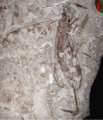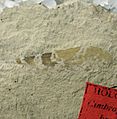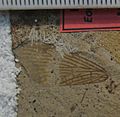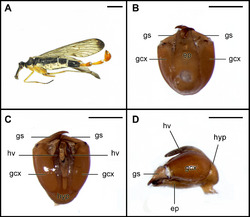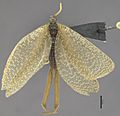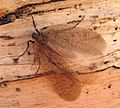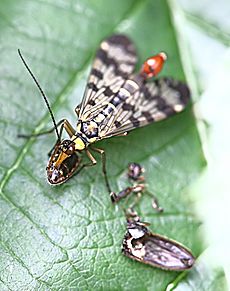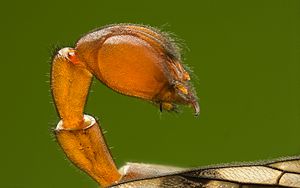Mecoptera facts for kids
Quick facts for kids MecopteraTemporal range: Permian - Recent
|
|
|---|---|
 |
|
| Panorpa communis, male | |
| Scientific classification | |
| Kingdom: | |
| Phylum: | |
| Class: | |
| Superorder: |
Panorpida
|
| Order: |
Mecoptera
Hyatt & Arms, 1891
|
| Families | |
|
|
Mecoptera (from the Greek: meco- = "long", -ptera = "wings") are an order of insects with about 550 species in nine families worldwide. Mecoptera are sometimes called scorpionflies after their largest family Panorpidae, in which the males have enlarged genitals that look similar to the stinger of a scorpion. The Bittacidae, or hangingflies, are a prominent family of elongate insects known for their elaborate mating rituals, in which females choose mates based on the quality of gift prey offered by various males.
Contents
Evolution and phylogeny
Mecoptera have special importance in the evolution of the insects. Two of the most important insect orders, Lepidoptera (butterflies and moths) and Diptera (true flies), along with Trichoptera (caddisflies), probably evolved from ancestors belonging to, or strictly related to, the Mecoptera. Evidence includes anatomical and biochemical similarities as well as transitional fossils, such as Permotanyderus and Choristotanyderus, which lie between the Mecoptera and Diptera. The group was once much more widespread and diverse than it is now, with four suborders during the Mesozoic.
Fossil history
The Mecoptera's crown group includes Nannochoristidae of Upper Permian age. Fossil Mecoptera become abundant and diverse during the Cretaceous, for example in China, where panorpids such as Jurassipanorpa, hangingflies (Bittacidae and Cimbrophlebiidae), Orthophlebiidae, and Cimbrophlebiidae have been found.
Extinct Mecoptera species may have been important pollinators of early gymnosperm seed plants during the late Middle Jurassic to mid–Early Cretaceous periods. These were mainly wind-pollinated plants, but fossil mecopterans had siphon-feeding apparatus that could have fertilized these early gymnosperms by feeding on their nectar and pollen. The lack of iron enrichment in their fossilized probosces rules out their use for drinking blood. Eleven species have been identified from three families, Mesopsychidae, Aneuretopsychidae, and Pseudopolycentropodidae within the clade Aneuretopsychina. Their lengths range from 3 mm (0.12 in) in Parapolycentropus burmiticus to 28 mm (1.1 in) in Lichnomesopsyche gloriae. It has been suggested that these mecopterans transferred pollen on their mouthparts and head surfaces, as in bee flies and hoverflies today, but no such associated pollen has been found, even when the insects were finely preserved in Eocene Baltic amber. They likely pollinated plants such as Caytoniaceae, Cheirolepidiaceae, and Gnetales, which have ovulate organs that are either poorly suited for wind pollination or have structures that could support long-proboscid fluid feeding. The Aneuretopsychina were the most diverse group of mecopterans in the Latest Permian, taking the place of the Permochoristidae, to the Middle Triassic. During the late Triassic though the Middle Jurassic Aneuretopsychina species were gradually replaced by species from Parachoristidae and Orthophlebiidae, the later of which modern mecopteran families are derived from.
-
Miriholcorpa forcipata, (no assigned family), Middle Jurassic; China
-
Forewing of Dinokanaga andersoni (Dinopanorpidae), Eocene; Washington state
Biology
Morphology
Mecoptera are small to medium-sized insects with long rostrums, membranous wings and slender, elongated bodies. They have relatively simple mouthparts, with a long labium, long mandibles and fleshy palps, which resemble those of the more primitive true flies. Like many other insects, they possess compound eyes on the sides of their heads, and three ocelli on the top. The antennae are filiform and contain multiple segments.
The fore-wings and hind wings are similar in shape, being long and narrow, with numerous cross-veins, and somewhat resembling those of primitive insects such as mayflies. A few genera, however, have reduced wings, or have lost them altogether. The abdomen is cylindrical with eleven segments, the first of which is fused to the metathorax. The cerci consist of one or two segments. The abdomen typically curves upwards in the male, superficially resembling the tail of a scorpion, the tip containing an enlarged structure.
The caterpillar-like larvae have sclerotinised heads with mandibles, short thoracic legs, prolegs on the first eight abdominal segments and a suction disc or pair of hooks on the terminal tenth segment. The pupae are exarate (the appendages are free rather than being secured within a cocoon).
Diversity
Mecopterans vary in length from 2 to 35 mm (0.1 to 1.4 in). There are about six hundred known extant species, divided into thirty-four genera in nine families. The majority of the species are contained in the Panorpidae and Bittacidae families. Besides this there are about four hundred known fossil species in about eighty-seven genera, which show a greater degree of diversity than do the living members of the order.
Distribution of mecopterans is worldwide; the greatest diversity at the species level is in the Afrotropic and Palearctic realms, but there is greater diversity at the generic and family level in the Neotropic, Nearctic and Australasian realms. They are absent from Madagascar and many islands and island groups; this may demonstrate that their dispersal ability is low, with Trinidad, Taiwan and Japan, where they are found, having had recent land bridges to the nearest continental land masses.
Ecology
Mecopterans mostly inhabit moist environments although a few species are found in semi-desert habitats. Scorpionflies, family Panorpidae, generally live in broad-leaf woodlands with plentiful damp leaf litter. Snow scorpionflies, family Boreidae, appear in winter and are to be seen on snowfields and on moss; the larvae being able to jump like fleas. Hangingflies, family Bittacidae, occur in forests, grassland and caves with high moisture levels. They mostly breed among mosses, in leaf litter and other moist places, but their reproductive habits have been little studied, and at least one species, Nanochorista philpotti, has aquatic larvae.
Adult mecopterans are mostly scavengers, feeding on decaying vegetation and the soft bodies of dead invertebrates. Panorpa raid spider webs to feed on trapped insects and even the spiders themselves, and hangingflies capture flies and moths with their specially modified legs. Some groups consume pollen, nectar, midge larvae, carrion and moss fragments. Most mecopterans live in moist environments; in hotter climates, the adults may therefore be active and visible only for short periods of the year.
Life-cycle
The female lays the eggs in close contact with moisture, and the eggs typically absorb water and increase in size after deposition. In species that live in hot conditions, the eggs may not hatch for several months, the larvae only emerging when the dry season has finished. More typically, however, they hatch after a relatively short period of time. The larvae are usually quite caterpillar-like, with short, clawed, true legs, and a number of abdominal prolegs. They have sclerotised heads with compound eyes and mandibulate mouthparts. The tenth abdominal segment bears either a suction disc, or, less commonly, a pair of hooks. They generally eat vegetation or scavenge for dead insects, although some predatory larvae are known. The larva crawls into the soil or decaying wood to pupate, and does not spin a cocoon. The pupae are exarate, meaning the limbs are free of the body, and are able to move their mandibles, but are otherwise entirely nonmotile. In drier environments, they may spend several months in diapause, before emerging as adults once the conditions are more suitable.
Interaction with humans
Forensic entomology makes use of scorpionflies' habit of feeding on human corpses.
Scorpionflies are sometimes described as looking "sinister", particularly from the male's raised "tail" resembling a scorpion's sting. A popular but incorrect belief is that they can sting with their tails.
Images for kids
See also
 In Spanish: Mecoptera para niños
In Spanish: Mecoptera para niños




